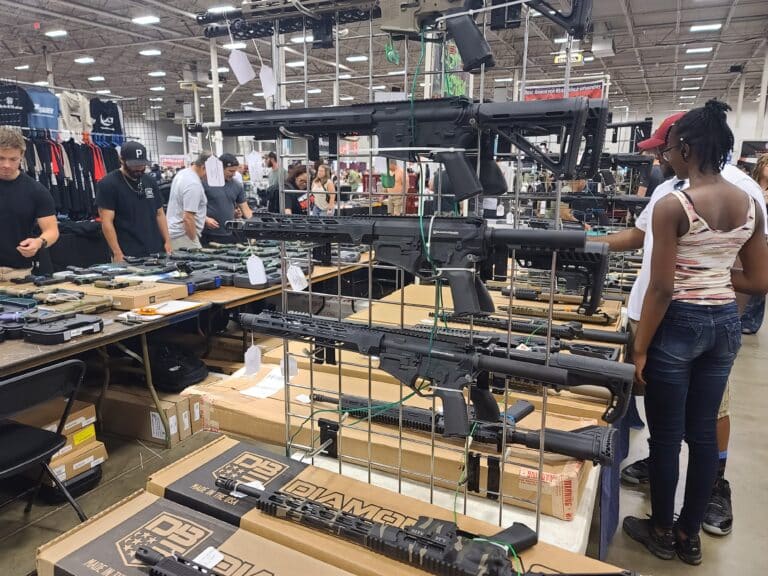Can AR-15s be “commonly used” arms afforded protection by the Second Amendment while the magazines that usually come with them are not? At least one federal judge seems to think so.
Last Tuesday, US District Judge Peter Sheridan struck down New Jersey’s ban on AR-15s (and only AR-15s) as unconstitutional under the Second Amendment. At the same time, he ruled that the state’s related prohibition on ammunition magazines capable of holding more than ten rounds was on solid legal footing.
“The AR-15 Provision of the Assault Firearms Law is unconstitutional under Bruen and Heller as to the Colt AR-15 for use of self-defense within the home,” Judge Sheridan wrote in Cheeseman v. Platkin. “In contrast, the LCM Amendment is constitutional under these same decisions.”
Even among the disparate outcomes reached by judges grappling with the Supreme Court’s new Second Amendment test over the last two years, Judge Sheridan’s reasoning stands out. Most lower courts evaluating “assault weapon” and magazine bans to this point have treated them as nearly one and the same—either by striking each down or, more commonly, upholding both. Judge Sheridan’s treatment of New Jersey’s similar bans uniquely splits the difference.
First, his analysis held AR-15s as distinct from every other class of semi-automatic firearm implicated by New Jersey’s sales ban. He justified that decision by arguing that the court was not as fully briefed on the other classes of affected firearms.
“[T]he information presented to the Court focuses largely on one specific type of firearm: the AR-15,” he wrote. “And given the variety of firearms regulated in the Assault Firearms Law and the nuances that each individual firearm presents, the Court’s analysis of the Assault Firearms Law is limited to the firearm with which the Court has been provided the most information: the AR-15.”
However, with that narrowed scope, he did apply the precedents established in Heller and Bruen in a way most gun-rights advocates would view as faithful. In determining whether AR-15s are “arms” protected by the plain text of the Second Amendment, Judge Sheridan rejected a reading of the “in common use” test defenders of AR-15 bans and judges who have upheld them alike have coalesced around.
“As is relevant here, the State Defendants appear to ask the Court to use a common use standard that grafts (1) common use with (2) a lawful purpose along with (3) evidence of the total number of self-defense incidents involving the relevant firearm in question,” he wrote. “This requirement, however, does not appear to have a threshold number that Plaintiffs must meet to show that a weapon is in common use for self-defense.”
Instead, he noted that there are currently tens of millions of AR-15s in civilian circulation, that the rifle has characteristics that make it “well-suited” to self-defense, and that there is evidence of its use in several recent “high-profile self-defense events.” He found that was enough to meet the burden of demonstrating that the rifle is “commonly used for a lawful purpose.”
“Following the guidance set forth in Heller and reiterated in Bruen, the plain text of the Second Amendment covers the individual conduct at issue here,” he concluded.
Judge Sheridan even suggested that this fact alone made subjecting the ban to a historical inquiry unnecessary since he said a total prohibition on a firearm clearing the common use test automatically fell outside of the nation’s historical tradition of gun regulation.
“Like in Heller, the Assault Firearms Law’s AR-15 Provision acts effectively as the total prohibition on a commonly used firearm for self-defense—AR-15s—within the home; the text of New Jersey’s Assault Firearms Law prohibiting a list of sixty-six weapons, including the Colt AR-15 defined in the AR-15 Provision,” he wrote. “The AR-15 Provision is impermissible under the plain text of Heller.”
When he turned to the magazine analysis, however, Judge Sheridan took a different tact. While he accepted the Third Circuit’s precedent that magazines are considered “arms” under the Second Amendment and that “large capacity magazines are commonly owned,” he did not stop his inquiry there under Heller as he did with AR-15s. Instead, he turned to New Jersey’s justification for its regulation “by examining its reasons for regulating large capacity ammunition magazines and their consistency with our Nation’s historical tradition of firearm regulation.”
He justified this distinction by stating that New Jersey’s categorical ban on AR-15s is facially similar to Washington DC’s categorical ban on handguns the Court struck down in Heller, but not facially similar to its categorical ban on magazines capable of holding more than ten rounds (that often come standard with AR-15s).
Rather, the more “nuanced analysis” alluded to by Justice Thomas in his Bruen opinion—one that courts that have upheld hardware bans almost universally appeal to—was instead called for in Judge Sheridan’s view. He argued that the modern problem of mass shootings allowed him to undertake a broader interpretation of historical weapons laws and concluded that mid-19th-century Bowie knife restrictions fit the bill as an appropriate analogue for the magazine ban.
“Once Bowie knives’ potential misuse became apparent, restrictions were enacted in all other states or territories–with the exception of New Hampshire–within the next few decades and up until the Twentieth Century,” Sheridan wrote.
Despite acknowledging that “few states prohibited the complete sale of Bowie knives” and instead mostly limited public carry or sales to minors, he said such restrictions formed the basis for “a tradition of prohibiting a subset of arms that could be useful and had become common for self-defense yet nevertheless posed a threat to public safety.”
“Like these restrictions, the LCM Amendment is precisely that–a restriction responding to safety concerns present in our time,” he said.
Overall, Sheridan’s opinion is a mixed bag.
His AR-15 analysis suggests that the Supreme Court’s Second Amendment precedents are constraining enough to bind, at least somewhat, the discretion of judges personally sympathetic to gun-control measures. Sheridan prefaced his opinion by expressing his distaste for the Supreme Court’s approach to gun rights and his thinly veiled desire for restrictive policy options.
“It is hard to accept the Supreme Court’s pronouncements that certain firearms policy choices are ‘off the table’ when frequently, radical individuals possess and use these same firearms for evil purposes,” he wrote. “Even so, the Court’s decision today is dictated by one of the most elementary legal principles within our legal system: stare decisis. That is, where the Supreme Court has set forth the law of our Nation, as a lower court, I am bound to follow it. This principle-combined with the reckless inaction of our governmental leaders to address the mass shooting tragedy afflicting our Nation-necessitates the Court’s decision.”
It also suggests, however, that the Supreme Court has not been so binding as to completely restrict that discretion.
“In the past, legislators took action to prevent these societal problems with limitations as the State of New Jersey has done here,” Judge Sheridan wrote. “This burden on the people of New Jersey’s right to self-defense is comparable to that imposed by these historical laws. As such, these historical analogues provide the basis for the following conclusion: that the State may regulate the permissible capacity of the large capacity magazines.”
Interestingly, the opinion also provides further evidence of the Rahimi decision’s minimal impact on most Second Amendment challenges since the Supreme Court handed it down in June. Judge Sheridan referenced the decision only once, in a section solely dedicated to summarizing the Supreme Court’s recent Second Amendment decisions, and never referred to it again throughout his legal analysis. Justice Thomas’ concerns about the Rahimi majority’s alterations of the Bruen test do not yet appear to have come to pass.
Since Bruen, the Supreme Court has been reluctant to take up new hardware ban cases. Until that changes, the door will remain open for lower court opinions to head in different directions, even within the same opinion.






One Response
The judge relies heavily on “self defense” to determine the restrictions on the arm in question. Did Bruen limit the application to self defense?
Self defense use is a severely overly-restrictive test. The 2nd amendment was not about self defense – it was about the ability of citizens to arm up and resist an oppressive government.